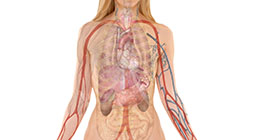
More than 100 years ago, cardiovascular disease was almost entirely a disease of men. Fifty years ago, the most popular explanations for gender-related differences in heart disease were lifestyle, including less stress for women (who were considered ‘happy homemakers’), and/ or the fact that women did not generally smoke until World War II. Today, women who have not yet reached menopause tend to have lower rates of heart disease compared to men. Postmenopausal women in North America, on the other hand, have equal rates of heart disease, with more women dying of heart attacks. Women in general also tend to have better high-density lipoprotein cholesterol levels (the ‘good’ cholesterol) and when women have higher good cholesterol, they tend to have less heart disease than men.
We have presumed for decades that women are protected from coronary disease by a built-in factor, presumably female sex hormones. This was based on the concept that all health issues in postmenopausal women have to do with declining female hormones. Several population studies suggested that a woman’s universal protection against heart disease is due to estrogen. And the medical community has perpetuated this belief because coronary heart disease is less common in women before the onset of menopause. Heart disease is more common in women who go through a premature natural menopause as well as more common in younger women who have had both ovaries removed during a hysterectomy.
Estrogen Does Not Predict Heart Disease Risk
Population-based evidence that heart disease death rates increase after menopause due to estrogen is actually weak. According to very thorough research published in the Journal of Clinical Epidemiology, there is very little evidence of a dramatic increase in heart disease due to estrogen levels in women. We do know that heart disease risk increases after menopause, but it has not clearly been shown to be to the result of declining estrogen. Researchers who do not support the theory that declining estrogen levels put women at risk of heart disease feel that estrogen may not be a primary player in heart disease development as it is for breast cancer. These researchers believe that the development of heart disease may have many factors, making it much more difficult to prove estrogen’s major role.
Some suggest that estrogen is simply not a major factor in the development of heart disease at all. In fact, there are actually no studies, according to research published in the British Medical Journal, that have shown estrogen levels in the body can predict cardiovascular disease in postmenopausal women. Estrogen levels are very poorly predicted in blood and none of the cardiovascular studies used saliva testing to get a more accurate picture of estrogen. Plus, there are many other hormones involved in heart-health protection, including testosterone and progesterone.
Hormone replacement therapy (HRT)—which generally includes synthetic conjugated equine estrogens (Premarin) and synthetic progestins like Provera (progestins are not progesterone)—has been available since the 1940s. Early observational studies suggested favorable effects in postmenopausal women using HRT. An increase in good cholesterol is seen in women using estrogen alone. And a deluge of other observational studies followed in an attempt to prove that HRT was the answer to postmenopausal coronary heart disease.
But interestingly, along the way, most studies showed an increased risk of blood clots and heart attacks in women who had just begun HRT. Then the Women’s Health Initiative study, which was designed to end the confusion once and for all about whether HRT was safe and could prevent or reduce the risk of coronary heart disease in women, was prematurely and abruptly halted in 2002 due to safety concerns. Was HRT found to be beneficial for heart disease? The answer was a resounding ‘No’ and now a paradigm shifts in the way doctors treat coronary heart disease in postmenopausal women is occurring. Let’s look at the major studies along the way.
The Coronary Drug Project
The Coronary Drug Project completed in the 1960s was the first clinical trial designed to determine whether estrogen reduced the risk of coronary events. Men with known heart disease were randomly assigned to one of five active therapies or a placebo. Two of the study medications were conjugated estrogens at a daily dose of either 2.5 or 5.0 mg; the estrogen arms were stopped early because estrogen-treated men had an increased rate of blood clots and heart attacks. After estrogen failed to protect men, no large heart-related estrogen trials were initiated in men or women for the next 23 years.
Yet despite the absence of clinical trial data, by the middle of the 1990s, it was accepted as dogma that HRT would prevent coronary heart disease in postmenopausal women. The medical profession went so far as to consider any doctor who did not recommend estrogen therapy unethical. In the wake of this, one very important researcher, Stephen B. Hulley, believed that a clinical trial showing safety and benefit in women was essential. He obtained funding for the secondary prevention trial that came to be known as the Heart and Estrogen/Progestin Replacement Study (HERS).
The HERS Trial
The HERS was the first large clinical trial designed to evaluate whether estrogen plus progestin therapy reduced the risk of coronary events in postmenopausal women who already had coronary disease.
This study, funded by Wyeth-Ayerst, was a multiple-center, randomized, double-blind, placebo-controlled trial. It included 2,763 postmenopausal women averaging 67 years of age. Each woman had an intact uterus and documented incidences of coronary heart disease. They were given a daily tablet containing conjugated equine estrogens (0.625 mg), medroxyprogesterone acetate (2.5 mg), or a placebo.
The study lasted about four years. The HERS showed no difference in coronary heart disease outcomes between the treatment and placebo groups. Non-fatal heart attacks or coronary heart disease deaths occurred in 179 women in the hormone group and 182 women in the placebo group, meaning there was no difference. This result occurred even though LDL (the bad cholesterol) decreased, and HDL (the good cholesterol) increased in the group getting HRT.
So, there was no benefit. And the really scary information is that in the first year of treatment, there was a significant 52 percent increased risk of coronary heart disease events in the group using hormones. Half of the women were followed for an additional 2.7 years and did not show any evidence of long-term cardiovascular benefit. Stroke and peripheral artery disease also did not differ between the group getting HRT and the group getting a fake pill. In other words, HRT did not make any difference and increased the risk of an adverse coronary event in the first year of treatment.
Further major studies showed an early increase in coronary death and non-fatal heart attacks in those prescribed HRT. But the medical community continued to prescribe hormones to prevent and treat heart disease. And more women died as a result.
A great debate ensued over why the trial results did not match the belief. Researchers said the women were too old or too sick. But this was not true; the average age was 67 (the average age whereby cholesterol-lowering drugs are researched). And the women were not too sick. Most had been excluded if they had had diabetes, congestive heart failure, a recent heart attack or vein disease. And over 75 percent of the women were compliant in the study. And we agree that they were prescribing the wrong hormones, including horse estrogens and synthetic progestins, which are not identical to the estrogens made by the body. The one valid criticism of the study was that it was only a single trial, possibly administering the wrong hormones. But many smaller studies also showed an increased risk of cardiac events.
By this point, significant studies showed an early increase in coronary death and non-fatal heart attacks in those prescribed HRT. But the medical community continued to prescribe hormones to prevent and treat heart disease. And more women died as a result.
The PHASE Study
In this study, a team of researchers completed an un-blinded trial with 255 women who had proven heart disease. The women, averaging 66 years of age, were either given no treatment or a 17 ß-estradiol patch (2.5 mg). No synthetic progestins were given. The patch was administered alone every four days to women without a uterus or, for women with a uterus, over 14 days, followed by four patches containing 3 mg of 17 ß-estradiol and 4 mg of norethisterone. However, the study was eventually halted due to a lack of benefits.
After approximately 31 months, it was found that there were no differences between the group receiving hormones and the group having no treatment. But the researchers found that beginning in the first year. The hormone group had higher rates of all cardiovascular events except non-fatal heart attacks. Neither an increase in good cholesterol nor a decrease in bad cholesterol was observed, and this was expected since the hormones were delivered transdermally (via the skin).
The WHI Study
The Women’s Health Initiative Study (WHI) was supposed to put to rest all concerns that arose from earlier hormone studies. This randomized, double-blind, placebo-controlled clinical trial was designed to look at coronary heart disease prevention in the form of hormone therapy, diet and calcium supplementation on disease outcomes in healthy postmenopausal women aged 50 to 79. In the hormone arm of the study, 16,608 women who had an intact uterus were randomly assigned to receive a single daily tablet containing conjugated equine (horse) estrogens (0.625 mg) and medroxyprogesterone acetate (2.5 mg) or a placebo. This was the same treatment given in the HERS. Another 10,739 women without a uterus were randomly assigned to placebo or conjugated equine estrogen (0.625 mg/d) without synthetic progestins. The study evaluated fatal and nonfatal heart disease, breast cancer, and bone health.
Even though many earlier trials showed cardiovascular risks, this trial, in particular, caught the attention of the media. After the first two-year follow-up, and then after one to two years, the Data and Safety Monitoring Board advised researchers that there was an early excess risk of heart attack and stroke in women assigned to the estrogen arms. All women were sent a letter to this effect, but most continued the treatment anyway. This is surprising considering the risk of death. In 2002, it was found that the combined estrogen-progestin arm of this study was linked to a 29 percent increase in heart attacks and a 41 percent increase in the incidence of stroke. Other adverse effects resulting from the HRT were also found, affecting the incidence of breast cancer, Alzheimer’s dementia, and even hearing loss.
The PEPI Trial and Bioidentical Progesterone
The Postmenopausal Estrogen/Progestin Interventions trial was a three-year trial involving 875 women who were perimenopausal (within 10 years of menopause). This trial was not designed to study disease outcomes.
Estrogen, when given alone, increases good cholesterol (HDL). When estrogen was given with progestins, a decline in good cholesterol was discovered. In the PEPI trial, women were given either placebo, conjugated equine estrogens, conjugated equine estrogens and synthetic progestins, either cyclical or non-cyclical, or conjugated equine estrogens and bioidentical micronized progesterone.
Of all the groups, the one receiving bioidentical progesterone had superior increases in good cholesterol. Bioidentical progesterone not only opposes estrogen’s negative effect on the uterine lining but is also very important for the heart.
Bioidentical Progesterone vs. Provera®
To protect the uterine lining from continuous stimulation by estrogen, most physicians prescribing standard estrogen repletion therapy (ERT) combine it with Provera®. If you ask if it is progesterone, you will probably even be told that it is—but it is not. It is medroxyprogesterone acetate, which is natural progesterone altered by adding a molecule to make it patentable and more orally absorbable. This molecule alters Provera’s® effect on tissues other than the uterus.
Many women discontinue ERT because they do not like how it makes them feel—irritable and often depressed. In contrast, bioidentical micronized progesterone is often called the feel-good hormone because it elevates mood and is calming. Women who have experienced mood swings and migraine headaches on Provera® notice complete resolution of these symptoms when switching to bioidentical progesterone. In addition, bioidentical progesterone was found to have the best effect on HDL cholesterol in the PEPI trial. This trial is the largest to date to include bioidentical micronized progesterone. Bioidentical progesterone can also act as a natural diuretic, in contrast to Provera®, which causes fluid retention and bloating.
There is, however, an even more compelling reason to avoid Provera®. Researchers have shown that Provera® can reverse by 50 percent the coronary-artery-dilating effect of estrogens and that bioidentical progesterone does not have this adverse effect. This evidence comes from recent studies by several different researchers and thus is unlikely to be disproved.
What Is a Woman to Do?
The WHI study has created a paradigm shift in how doctors treat heart disease. No longer is it a medical sin not to prescribe hormones to women. Now we realize that caution is needed when prescribing hormones to any woman.
If you are at risk of cardiovascular disease, do not take synthetic hormones at all—not even at a low dose for the short term. See heart disease for advice to help prevent and help treat any existing cardiovascular symptoms you may have. If you are suffering from menopausal symptoms and need relief, follow the safety advice for addressing menopausal symptoms.











